 |
 |
 |
HOME > FOCUS > Need a Getaway? Try Sakushima, an Island Art Enclave in Aichi |
 |
 |
Focus features two in-depth reviews each month of fine art, architecture, and design exhibitions at art museums, galleries, and alternative spaces around Japan. |
|
|
 |
 |
 |
Need a Getaway? Try Sakushima, an Island Art Enclave in Aichi
Susan Rogers Chikuba |
 |
Sakushima has atmospheric neighborhoods to wander, diverse art, a Buddhist pilgrimage that winds through forested trails, and quiet beaches where you can swim and fish freely.
|
You won't find a single traffic light, gas station, or convenience store on Sakushima, a tiny island in Mikawa Bay cradled by the Chita and Atsumi Peninsulas of Aichi Prefecture. You will, though, find well-marked signs in English and Japanese that keep you oriented as you ramble around sleepy fishing hamlets seeking out the 30 permanent artworks on display (only 22 of them are mapped). From time to time the island hosts special exhibitions that might be staged anywhere -- on a remote beach, for example, with installation assisted by fishermen who lend their boats. Sakushima also has a Kobo Daishi pilgrimage trail, established in 1916, that's been refurbished of late by architects and university students. If you're ready to turn on (or off), tune in, and drop out somewhere fresh now that travel bans are eased, the laid-back vibe here makes for just that kind of vacation -- with great seafood to boot.
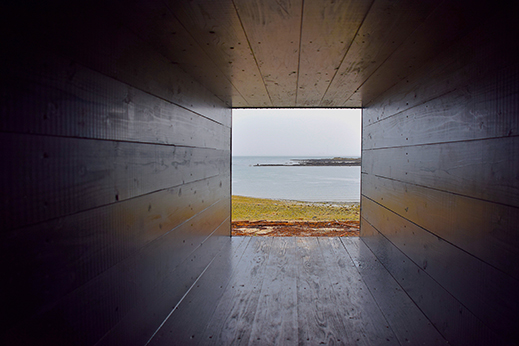 |
|
Detail of Ohirune hausu (Nap Hut), 2013, by architect Yuki Minamikawa. A cube with six openings you can climb up into and stretch out in, this work sits on the west shore of the inlet around which the island bends. Facing it across the water is East House, a companion piece by Minamikawa that is a prime spot for catching sunsets. Photo by Susan Rogers Chikuba
|
The story behind Sakushima's art program is a familiar one: revitalization undertaken to balance the downtrends wrought by depopulation and aging. While it doesn't have the glitz or scale of other art island projects like Naoshima in the Seto Inland Sea, or its regional spinoff festival Art Setouchi, that is precisely its charm. Slow and steady like the proverbial tortoise, art initiatives here are steered and championed by an inspired city council rather than corporate concerns or high-profile names. The island's connections with art and artists feel authentic and real, part of the fabric of the place.
Catching the eye here and there are old rusty signs like this one, retrieved from abandoned lots and shops and displayed on the streets like Warhol-esque pop art embellished by Nature. Photo by Susan Rogers Chikuba
|
The project began in 2001 with art fairs and workshops timed to coincide with Sakushima's traditional festivals. Fostering collaborations among residents, artists, and newcomers, these events drew new energies to the island in meaningful ways: more visitors came from the mainland to attend the festivals; local children had guest teachers for art class at school. One year the kids learned how to stamp and solder sheets of iron with sculptor Noe Aoki, then exhibited their works at Benten Salon, an art project itself. Formerly a residence dating back to 1878, it was repurposed to serve as a community center, museum, and exhibition space. The island's art initiatives also sync with its Kobo Daishi pilgrimage, a network of trails linking 88 wayside shrines. (The number models the 88-temple route in Shikoku that's named for the legendary priest, whose ninth-century exploits earned him the posthumous title gGrand Master of Buddhist Teaching.h) Some of these little structures that had fallen into disrepair over the decades have been creatively restored as artworks themselves.
|
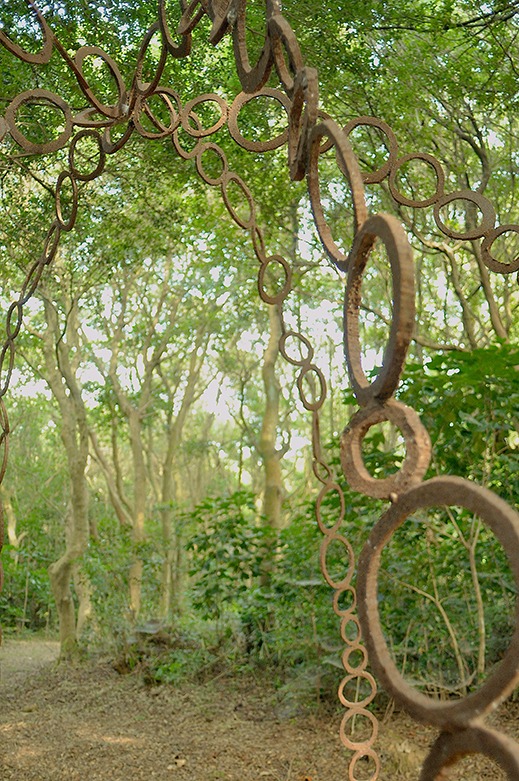 |
|
|
|
Detail of Sora no mizu--Yama (Sky Water: Woods), 2008, by Noe Aoki. Photo by Masayasu Koumura
|
Less than a square mile in size, Sakushima lends itself well to random wandering on foot or bicycle. (You can rent a bike if you're day-tripping, or borrow one from your inn if you're staying overnight.) Most of the island is covered in forest, with trails that traverse deep groves of bamboo, camellias, and plum trees, then meet up again with country lanes that crisscross the two hamlets at the east and west ends. The artworks pop up in unlikely places: in the middle of woods, inside an abandoned shop, on the veranda of a seemingly deserted temple. While there is plenty to explore, there is little chance of getting lost -- signage is thoughtfully planned and you're never far from the coastal route that almost circumnavigates the island.
|
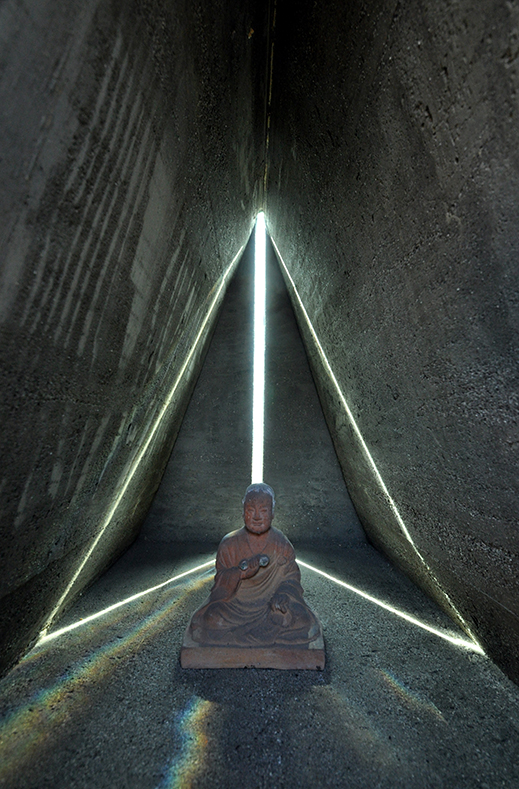 |
|
|
|
Sankaku (Triangle), 2011, a wayside shrine by architect Tsutomu Nagaoka. Photo by Masayasu Koumura
|
Commissioned by residents to design a wayside Kobo shrine that could withstand the elements from its perch on a rocky overlook at the southeastern tip of the island, architect Tsutomu Nagaoka devised Sankaku (Triangle), a concrete structure with a glass slit on its seaward side. When the morning sun reaches a certain height, its rays penetrate the slit and refract against the sloped walls, enveloping the enshrined monk in a polyhedron of light. The spectacle lasts for just an hour each day, typically from around 10 to 11 a.m. in the spring and autumn months.
Nearby, Apollo by Ben Nagaoka and Masahiro Tanaka sits on a rise at the end of a tunnel of trees. Cut with spy holes, it is the realization of Nagaoka's childhood dream to build a secret fort, and a nice place to rest with a thermos of tea as you enjoy the ocean views. The trail continues on to a place where you can climb down to Niya Beach, where the sand, composed primarily of ground-up mussel shells, glows with a soft purple hue. Deep archways of interlaced branches are prevalent on the island, by the way -- a strategy of the trees that enables them to withstand the ocean winds. Beautiful and relaxing in their cocooning way, these sylvan tunnels are another highlight of Sakushima's trails, as long as you don't mind being in close quarters with the bright-orange crabs that scuttle along with you, hurrying to get out from under your feet.
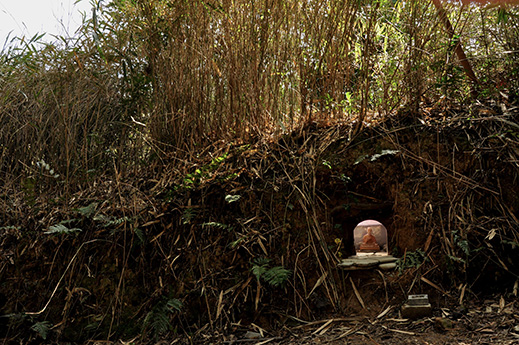 |
|
Namioto ga kikoeru mori no naka de: Ao (Blue: In Woods with the Sound of Lapping Waves), 2009, a wayside shrine by Masashi Sogabe of Mikan Architects. Photo by Masayasu Koumura
|
North of the purple-sand beach is a wayside Kobo shrine refurbished by architect Masashi Sogabe. Built right into an earthen embankment, it's illuminated by natural light only in the morning hours. The soft pink hue surrounding the enshrined figure comes from a backcloth dyed with the extract of local mollusks. As if this weren't poetic enough, Sogabe named the installation gBlueh for the chestnut tiger butterflies that frequent the area.
Over on the other side of the island Noe Aoki, an artist known for lithe sculptures rendered of industrial iron, chose a clearing atop a wooded knoll for her Sora no mizu--Yama (Sky Water: Land). More ether than solid matter, this see-through, walk-through dome of iron rings mimics the shape of several historical Kobo shrines that sit nearby. The work sways a bit, evoking the artist's concept of life-giving water that flows between heaven and earth, circulating all around us. Its predecessor, Sora no mizu--Umi (Sky Water: Sea), was a temporary work installed so as to stand in the swash at high tide on a rocky beach at the island's opposite end.
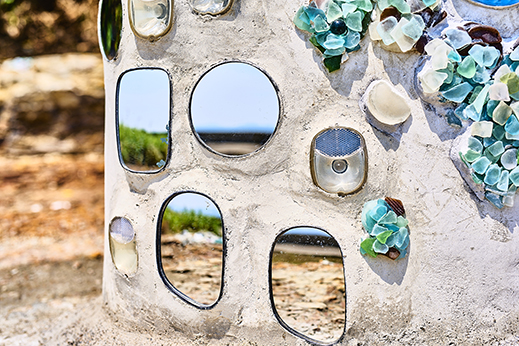 |
|
Detail of Hoshi o omou basho (Place for Celestial Contemplation), 2017, by Yukari Araki. Photo by Yoshihiro Ozaki |
At the island's quiet northeastern tip, near where the vehicular road ends and gives way to walking trails, is Hoshi o omou basho (Place for Celestial Contemplation), a well-like structure by Yukari Araki. She adorned its walls with sea glass, shells, and seedpods collected on the island, as well as lamps and side mirrors from old cars and scooters given to her by residents. The mirrors reflect the surroundings of beach and surf. From the top of the well, you peer down into a cerulean cosmos of still more detritus from life on earth: crab claws and strands of sea grass float along with hat pins, capsule toys, Mardi Gras beads, a blue elephant, bright red scissors, and more, the whole suspended in a sea of epoxy resin and glitter. The objects appear to shift in depth depending on the ambient light, and the artist describes the assemblage as gfragments of starsh -- which, of course, it is.
 |
|
Many of the homes in the photogenic hamlet on the west side of the island are cladded in black, after the traditional creosote paint used as protection against the salty air. If you park your bike and explore on foot, chances are a resident will invite you in for tea, or a friendly cat will invite you to rub its whiskers. Photo by Susan Rogers Chikuba |
Photos by permission of Nishio City.
|
Sakushima can be accessed from Nagoya Station in less than two hours. Take the Meitetsu Line to Kirayoshida Station (70 minutes) and a taxi from there to Isshiki Port (15 minutes). From there the ferry ride is 20 minutes. From Chubu Centrair International Airport, Isshiki Port is 50 minutes by car. Photo courtesy of Nishio City |
 |
 |
Susan Rogers Chikuba
Susan Rogers Chikuba, a Tokyo-based writer, editor and translator, has been following popular culture, architecture and design in Japan for three decades. She covers the country's travel, art, literary and culinary scenes for domestic and international publications. |
|
 |
|
|
 |
|
 |
|